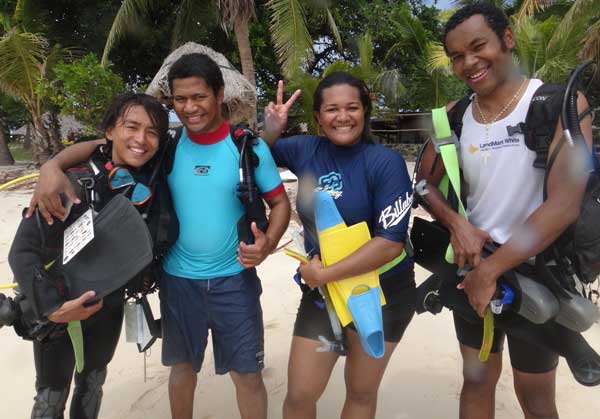WHILE tourists lay lazily on the beach in a typical sunny day at Mana Island Resort, four divers and a photographer were busy at work beneath the waves of the North Beach.
On the ocean floor about eight meters deep lay seven tables-full of live corals, most was planted about seven months ago.
Two cages of giant clams were among them. Because it was low tide, their shell opening never closes completely and they appear like colourful thick lips in between the wavy shell opening.
It is a mistaken belief that divers can be trapped underwater if the giant clam closes over their foot or hand. But many of these peaceful clams can’t even close their shells completely. Thank God, they certainly don’t eat people.
The mission was to transplant at least one cage along the steep, bony face of a dying coral reef.
In less than 50 minutes, 20 coral cookies was resettled, each carried a tiny sliver of hope for the reef of this beautiful island resort.
Six more tables now remain beneath the sapphire-blue ocean of Mana Island’s North Beach waiting for their turn to be replanted in the not so distant future.
Destruction of coral reef is one of the major concerns of ecologists worldwide and the picturesque Mamanuca Islands are not spared.
Aqua Trek Mana dive Instructor Asami Dantsuka who treats reefs at Mana Island as her backyard garden said coral numbers has decline tremendously in the past five years.
“One of their snorkelling and diving site was really affected and we never go there anymore. Crown of thorns was our major threats and it has affected most of our reef,” she said.
But Ms Dantsuka is forever optimistic that coral transplanting is the answer.
“What we can say is that it has helped the affected site with new coral blooming nearby the transplanting site. We are seeing it happening, as long as we keep educating people the importance of conservation i think we can revive some of this affected sites.”
“We have done four transplanting already with the Mamanuca Environment Society and we are still trying the best method that can fit our reef. But it is working well,” says Ms Dantsuka.
Coral Transplanting Project was first introduced to the Mamanucas in 2009 by the Mamanuca Environment Society (MES)
MES Project Manager Betani Salusalu said restoration of degraded reefs is considered one of the major reef management strategies to help remedy the negative effects of human activities on coral reef eco-systems.
“There are two major approaches to reef restoration-coral transplantation and artificial reefs but coral transplantation is appealing because it is an efficient means of turning a bare reef into a highly covered reef and there is a scientific basis for the technique.”
“The primary objectives of coral transplantation are to improve reef quality’ in terms of live coral cover, biodiversity and topographic complexity.”
Mr Salusalu said there are many reasons for transplanting corals.
“It can be done to accelerate reef recovery after ship groundings, replace corals killed by sewage, thermal effluents or other pollutants, save coral communities or locally threatened rare species, accelerate recovery of reefs after damage by crown-of-thorns starfish, aid recovery of reefs following dynamite fishing or coral quarrying, mitigate damage caused by tourists engaged in water-based recreational activities, and enhance the attractiveness of underwater habitat in tourism areas. It is the perfect method.”
“Saving our reefs from the natural disasters and the climatic changes is a big concern for mankind. The reefs face a lot of threats because of the acidification of the oceans and coral bleaching.”
“The increase in the sea levels because of the climatic changes, which can be attributed to global-warming, has increased the erosion of these reefs. Saving them (reefs) is all about what we can manage to do to avoid these threats to save the environment.”
Mr Salusalu said the most common transplanting technique in most places involves breaking off pieces of adult coral and affixing them elsewhere on the reef.
While this method is quick and easy, he said, it gives the reef a smaller and less healthy gene pool besides damaging the host coral.
“The method we are using where coral cookies are stacked underwater for seven months or more near a healthy stretch of reef, allows coral larvae released during spawning to naturally attach and grow. This ensures that each cookie carries genetically distinct coral organisms, more closely replicating the results of natural reproduction.”
“It is expensive and labour intensive, but it brings more genetic diversity and thus healthy reefs,” said Mr Salusalu.



